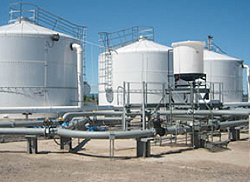
Four of these 50,000-gallon tanks will be used to test promising technologies for ballast water treatment systems.
Freshwater Test Facility Opens on Superior Waterfront
June 28, 2007
Al Miller, UW-Superior
The world's first freshwater test facility focusing on ballast water treatment technology opened June 28 in Superior, Wisconsin. The facility is a critical component of the "Great Ships Initiative," a cooperative effort among the Great Lakes maritime industry, federal agencies, and other regional stakeholders to stop ship-mediated introduction of aquatic invasive species into the Great Lakes.

This recreational vehicle has been converted to a mobile laboratory that scientists can use to follow a freighter around the Great Lakes to test the effectiveness of its ballast water treatment system.
The role of the Great Ships Initiative is to accelerate the development of commercially viable and environmentally protective ballast water treatment systems by providing a variety of assistance to those companies and institutions doing research and development in this area.
While certain aspects of the project are "virtual," in that scientific expertise is being tapped no matter its location, the project's lab space and testing center is located in Duluth-Superior harbor and is being jointly managed by the University of Wisconsin and the University of Minnesota.
The UW-Superior scientists will use the test facility with its four 50,000-gallon tanks to test promising technologies for treating ballast water. The technologies will be installed at the testing facility, and then tested on harbor water to determine whether they can remove or kill animals, plants and bacteria that could be found in a shipís ballast tanks.
As part of the Great Ships Initiative, the Lake Superior Research Institute at UW-Superior has equipped a mobile laboratory so scientists can follow a Canadian Great Lakes freighter that has a ballast water treatment system. Scientists will sample the shipís ballast water as it loads and unloads at various ports to test the systemís effectiveness.
Overall project management is being provided by the Northeast-Midwest Institute, and the National Fish and Wildlife Foundation, both of Washington, D.C. A twenty member Executive Committee provides project oversight.
Adolph Ojard, Duluth port director noted; "Aquatic invasive species are unwelcome hitchhikers; they are an unintended consequence of international maritime commerce. The sooner we develop technology to keep these organisms off ships, the sooner this problem will be solved."
The Great Ships Initiative received start-up funding of $500,000 through the efforts of Congressman David R. Obey (D-WI) in federal fiscal year 2005. Congressman Obey secured an equal amount in fiscal year 2006. Since that time, additional funds or in-kind contributions have been provided by the following project partners:
- U.S. Department of Transportation
- U.S. Maritime Administration
- St. Lawrence Seaway Development Corporation
- St. Lawrence Seaway Management Corporation
- National Oceanic and Atmospheric Administration
- Great Lakes Maritime Research Institute
- City of Superior
- Duluth Seaway Port Authority
- Port of Milwaukee
- Illinois International Port District
- Ports of Indiana
- The Toledo-Lucas County Port Authority
- Cleveland-Cuyahoga County Port Authority
- Erie-Western Pennsylvania Port Authority
- Port of Toronto, Ontario
- Port of Hamilton, Ontario
Additionally, the project has received endorsements from Wisconsin Governor, James Doyle, the Great Lakes Cities Initiative, Great Lakes United, a regional conservation organization, and Fednav Limited, the largest operator of ocean shipping on the Great Lakes.


